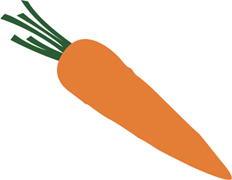
CARROTS
The carrots our forebears tugged from the soil may have been more appetising than other roots on offer, but they weren’t like the orange, juicy and sweet carrots we enjoy today. Those carrots only appeared around the 1500s. They were certainly seen as a healthy addition to the diet. ‘They do nouryshe with better iuyce than the other rootes,’ wrote Sir Thomas Elyot in 1536 in his popular Castell of Health that went through an impressive 17 printings. While our new-age carrots boast eye-catching hues, it’s their sweetness that makes them popular raw and cooked. They make a gorgeous, crunchy snack or side dish; are added to salads, soups, stir-fries and bakes; and are an essential ingredient in mirepoix and sofritos to flavour stocks, soups, stews and sauces. A roast dinner just wouldn’t be the same without them.
WHAT TO LOOK FOR
Whether they’re orange, red, yellow or purple, look for firm, bright skins that glow and have no signs of splitting. Generally, small to medium carrots will be better choices, often sweeter and juicier than large ones, which can be woody and fibrous. If buying bunches of baby carrots, avoid any with particularly wilted green tops.
HOW TO STORE THEM
Carrots like to be kept cool and moist or they will dry out. Pop them in a plastic bag in the fridge and use them up within a few days.
WHAT’S IN THEM?
A medium-sized raw carrot (about 130 g/4½ oz) has about 170 kilojoules (41 calories), 1 g protein, no fat, 6 g carbs (6 g sugars, 0 g starches), 5 g fibre, 49 mg sodium, 348 mg potassium, and a low GI (39); the GL is low (2).
WHAT ELSE?
Does colour make a difference? Prof. Philipp Simon, who has studied carrots of all colours for over 35 years and tasted hundreds of thousands of them, says that ‘Pigments don’t appear to affect the flavour, but overcooking gives them an unpleasant “violet” taste.’
HERO RECIPES
Carrot and red lentil soup with lemon (here )
Potato and silverbeet with a carrot, nut and oat crust (here )